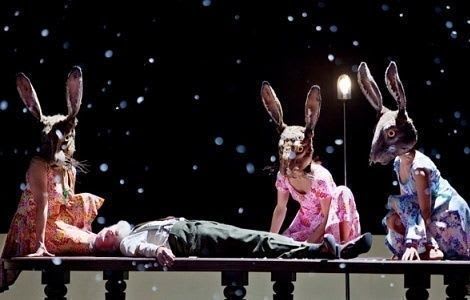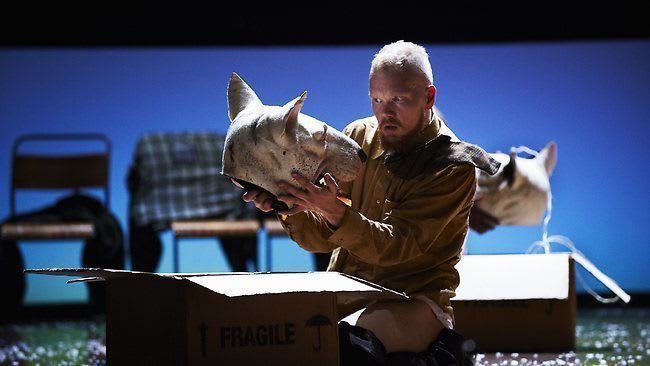Choreographer Michael Keegan-Dolan prefaces his version of The Rite of Spring typically idiosyncratically with a performer crawling under the house curtain, singing an Irish folk song and then ducking back again. The song, about hunting the hare (at least I think it was) is a clue to part of what follows.
When he has gone and the first chords of Stravinsky’s iconic score are heard (finely played by the full orchestra of the Royal Ballet Sinfonia, not two pianos as when the company presented its last version of this piece) the black-clothed figure of a witch-like woman, a Cailleach, enters in front of the curtain which then rises to reveal a line of men seated with cardboard boxes on their knees.
They are in modern dress with beanie hats and an older man seems to preside over them sitting in a chair on top of a table. The men bring their boxes down to the front of the stage, then three women appear from under the table.
Already it is beginning to feel like a ritual, a rural survival of ancient ceremony. Snow is falling, winter still rules as the staccato steps of the choreography match the rhythms of Stravinsky’s score.
Three girls appear from under a table, they go to one side while the men stamp around full of excitement and anticipation. Suddenly, they knock off one man’s beanie and strip him as he struggles, revealing that he is a woman whom they cast aside.
The three women in a parody tea party are served some kind of drug and go into tremors. The men crawl downstage over their prone bodies, then the women are given masks that turn them into hares.
Now the older man on his table is paraded, the women assault him and make him take tea too. The men pull down their trousers and pound the earth with their bodies, seed for the fertile earth. Post orgasm, they light up cigarettes: another mind-altering drug?
Now the boxes are distributed and the men open them, all matched to the music, they contain hound heads for the men. There is a menace that matches the music we are ready for the hunt.
Later, led by the Cailleach, the women stretch out a rope of multi-coloured cloth which the men pull apart. It was made up of women’s dresses and, first stripping themselves naked, the men put them on.
With snow once again falling, the ritual dances continue, led by the boy-woman just in bra and panties, but she isn’t a sacrificial victim. It is the men who symbolically fall to the ground in a rite still pagan in a rural world still ruled by the earth mother.
In Rite, Keegan-Dolan uses the stomping and the angularities that have often been a feature of previous versions but he also turns such simplicities as tea-pouring and untying string into dance ritual in a work that places primal traditions and Irish folklore in a contemporary setting, now perched on a pole high above everyone, still in command.
It begins with everyone, now all in white, throwing their Rite dresses into a great bundle to begin a series of dances all controlled by the woman above as white gauze walls are raised around them.
At first, everything is smiling and joyous as though celebrating the arrival of spring, but, though its springing dances are delightful to watch, this is a work that is far more difficult to interpret.
Though at one point there is an echo of the Moor, ballerina and Petrushka triangle, there is little link with the original scenario—no equivalent of Petersburg fairground, no dancing bear but just the black-clad woman on her perch pulling the strings just like the original’s puppet master.
When she flutters down papers bearing numbers for each of the dancers to wear, could it be a reference to the dance marathon competitions of the Great Depression? When each in turn assumes white-face before dancing a solo, what should we read into it? It ends with a powerful symbol, an escape or a heavenward apotheosis, but what does it mean?
Perhaps one should not even try to find specific meaning but just enjoy the patterns of the dance, now much more fluid than in Rite, and the energy and grace of the dancers. This ritual may be more obscure but it emphasises the way that in this juxtaposition highlights the musical similarities between the two works.
Indeed Petrushka, first performed in 1911, was written at the same period for Stravinsky had already begun to conceive Rite in 1910, though it was 1913 before its première in Paris.


